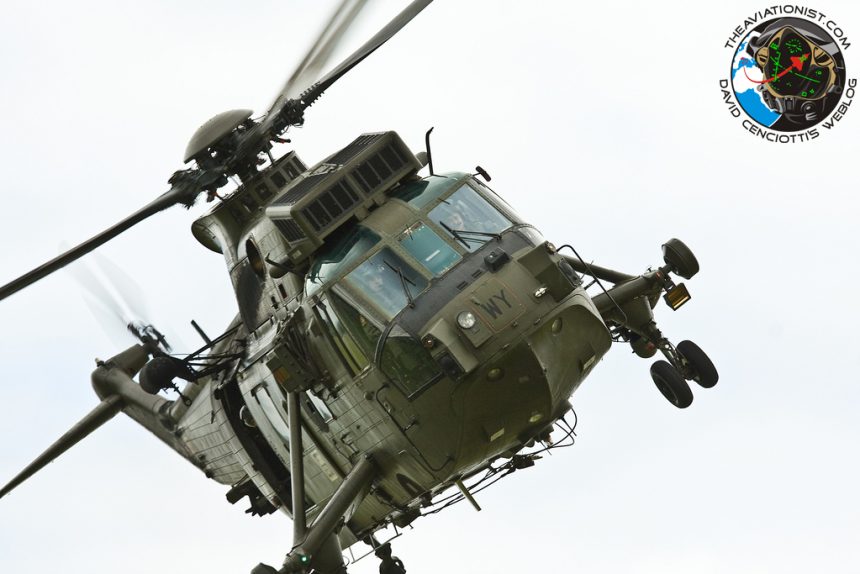The sinking of HMS Sheffield had made the Exocet missile a fatal threat to the Royal Navy…
During the Falklands conflict (Malvinas for the Argentine people) the Argentine Navy became the first in the world to sink an enemy ship in actual combat with the AM-39 Exocet air-to-ship sea-skimming missile. Although the Argentine Navy only had a total of five Exocets in its arsenal during the war, and only a handful of (five in total, but only four airworthy) Super Etendard aircraft capable of launching them, something had to be done to remove the threat of attack with Exocet missiles: a successful strike on a Royal Navy aircraft carrier could fatally compromise the Falklands campaign.
Whilst MI-6 mounted a covert clandestine operation to buy all Exocets from the black market, therefore removing the ability to re-supply the used munitions, the remaining weapons and aircraft that delivered the very effective weapon were still a concern.
The task to solve the issue was given to the British Army’s SAS (Special Air Service) and Royal Navy’s SBS (Special Boat Service).
B squadron of the SAS was ordered to draw up plans to destroy the remaining weapons and aircraft on their airfield on the Argentine mainland. The plan that came out of this order, which became known as “Operation Mikado”, was for B squadron to land at Rio Grande and destroy the weapons along with the aircraft, with a secondary mission to kill the pilots too.
According to the plan 55 men of B Squadron SAS were to fly in two C-130s direct from Ascension Island, land on the main runway at the Rio-Grande airbase at Tierra del Fuego, destroy any aircraft and weapons and then to storm the officers mess and take out any pilots they found. Once this was completed, they were to escape either in the C-130s to Chile (if the aircraft had survived) or make their way to Chile (50 miles away) on foot, a bit like the troops from the book Bravo Two-Zero did when they tried to walk to Syria.
Before any attack could be made, a reconnaissance mission was required to observe the airbase and send back intel on defenses and movements etc. Codenamed “Operation Plumb Duff” the mission was launched on May 16, 1982, from the Task Force (thought to be from HMS Hermes) in a stripped out Sea King MkIV which flew towards the Argentine mainland.
The plan was to put the SAS ashore from where the troops would walk to the airfield, set up an Observation Post (OP) and then send back the required intel.
The Sea King got to within 20 miles of the drop off point when it became enveloped in fog and navigation became almost impossible. The aircrew and SAS argued as to what to do.
Eventually, the SAS were dropped off and decided to carry on with the mission whereas the aircrew flew to Chile where the helicopter landed before it was set on fire (as planned) and destroyed.
Once the Chilean authorities found the remains of the Sea King the British tried to cover the reason why it was there. The aircrew were eventually picked up by the Chilean authorities 8 days later and returned to the UK, while the Special Forces team encountered a difficulty on the ground that prevented them from completing their task.
Whilst operation Plumb Duff was taking place, back in the UK, B squadron began practicing for the assault. All RAF bases were told to keep an eye out for attack but were not told when or what time the simulated raid would take place.
Using state of the art Night Vision Goggles, the C-130 aircrew flew at tree top height to try and hide their intentions prior to planting the transport plane onto a RAF base’s main runway. The rule book for night flying and any height restrictions was discarded and many people were woken in the dead of night by a high speed very low Herk trying to evade radar detection only a few feet above their house roof.
It was found that many of the radar operators at the various RAF bases detected the Herk a long time before it was anywhere near the airfield, a huge problem when trying to get near a hostile airfield.
Many people within the SAS started to express serious doubts on the whole operation. On the failure of Operation Plumb Duff many SAS senior officers suggested that the element of surprise was lost: one sergeant decided that the only way to get his point across was to resign and to add weight to his argument, the squadron commander also said that the operation was not viable; an opinion that cost him his command.
The SAS soldiers were ordered to fly to Ascension, the staging point for the operation, but once there it became clear that the Argentineans enjoyed far better radar coverage than had been previously thought and the operation was put on hold.
A plan B was then devised.
The SAS troops would be infiltrated on Gemini inflatable boats having been transported by a submarine HMS Onyx to a point just off the Argentine coast from where they would then “sneak” into the base and destroy the aircraft (this was also practiced by SAS in the Falklands using advice from the SBS).
This plan was given the go ahead but before it was carried out the Argentinean forces on the Falklands surrendered and the operation was cancelled.
It must be assumed that an observation post must have been in operation as the main assault was so close to taking place although there are no clues that this was true.






